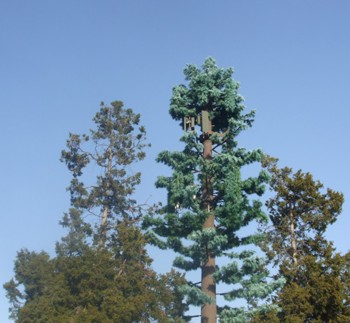Delta Groups Engineering Busy with New Cell Sites
Delta Groups Engineering Busy with New Cell Sites
Today's avalanche of mobile applications is turning into a boon for providers of telecommunications development services. Not only are cell transmission sites proliferating to meet the burgeoning demand for bandwidth, but stricter zoning regulations have triggered the need for new facility designs. The intrusive cell phone towers of old - a single steel pole (monopole) that supports four to six-foot-high antennas - have evolved. A combination of creativity and new materials now allows the sites to blend harmoniously into the landscape.
"Some of our best work is never seen," quips Bill Desmond, vice president of architectural and engineering services at Delta Groups Engineering. The firm specializes in the gamut of tasks that get new cellular facilities operational, everything from architectural and engineering design services to real estate acquisition and land-use planning services through general contracting via sister company Delta Groups Construction. "The only services we don't provide in-house are land-use surveying and geotechnical consulting," Desmond notes.
The latest transceiver stations are designed to keep all the gear, especially the antenna, completely hidden from view or at least camouflaged to be unrecognizable. The firm uses a variety of methods to create "stealth" sites. One of the most common disguises is the lifelike artificial tree, available in "a palette of species," such as the monopalm or monopine. "They are all based on the idea of a monopole that functions as a structural support shaft and then branches out with various types of faux foliage, for example, a eucalyptus with plastic leaves that form a canopy," Desmond explains.
Simulated clock towers and church steeples also make good antenna-concealing options. These free-standing structures have to be replicas because their original materials, namely wood, concrete, or stucco, tend to reflect or absorb radio signals. Their replacements are typically made of "radio frequency friendly" plastics or fiberglass materials, allowing the antennas to perform properly so signals pass through with minimal loss.
Established in 1986, Irvine-headquartered Delta Groups has been a stable presence in the very cyclical telecom field for more than two decades. Many of its initial competitors are no longer in business. Over the years the firm has successfully weathered the industry's fluctuations, now finding itself in another peak.
A flurry of activity among facilities designed anywhere from five to 20 years ago is bringing Delta Groups a lot of business, Desmond reports. "Carriers are coming back asking for modifications because of the need to change out hardware and increase capacity. It is most efficient for them to work with us again as the original vendor. We already have the design documents for the initial construction, so it's very cost effective for us to design the modifications. We see that happening more and more frequently."
Desmond himself moved up from Irvine to open the Pleasanton in 1996, in response to a specific client project, the Sprint-PCS network build out. Once the office was up and running, it became the springboard for other West Coast projects. Delta Groups has operated up to nine regional offices, as far afield as Florida and New York, but the Pleasanton facility, with its current staff of 11, remains the firm's second largest, after headquarters.
For more information, visit www.deltagroups.com.
Photo: Delta Groups installed antennas on this "tree pole."
Also in this issue...
- New RE/MAX Accord Office Emphasizes Confidence in the Housing Market
- Start-Up Rolith Tackles Industrial-Scale Nanostructured Coatings
- Business Bits
- Executive Profile: Ron Bissinger, Aplegen
- Delta Groups Engineering Busy with New Cell Sites
- Visioneer Deepens Sustainability Commitment with "Where There Is a Need" Charitable Program
- City of Pleasanton Services at a Glance
- Hacienda Rolls Out Riiwards.com in Time for Holiday Selling
- Spectrum of Science Offers Special Camps in December and May
- TVHOC's Giving Campaign Emphasizes Link Between Employee Housing, Well-Being
- 1st Annual Foundation Gala
- Hacienda Online!
- Hacienda Index
- Calendar





